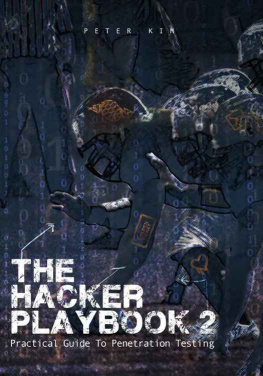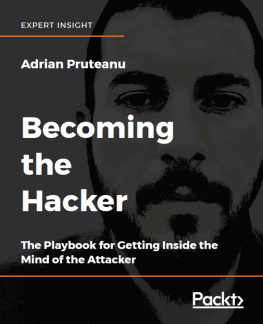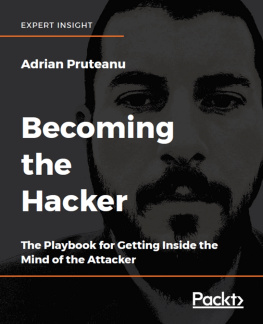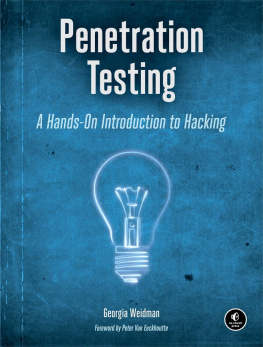Copyright 2018 by Secure Planet LLC. All rights reserved. Except as permitted under United States Copyright Act of 1976, no part of this publication may be reproduced or distributed in any form or by any means, or stored in a database or retrieval system, without the prior written permission of the author.
All rights reserved.
To my wife Kristen, our new baby boy, our dog Dexter, and our families.
even when you had no clue what I was talking about.
preface
This is the third iteration of The Hacker Playbook (THP) series. Below is an overview of all the new vulnerabilities and attacks that will be discussed. In addition to the new content, some attacks and techniques from the prior books (which are still relevant today) are included to eliminate the need to refer back to the prior books. So, what's new? Some of the updated topics from the past couple of years include:
- Abusing Active Directory
- Abusing Kerberos
- Advanced Web Attacks
- Better Ways to Move Laterally
- Cloud Vulnerabilities
- Faster/Smarter Password Cracking
- Living Off the Land
- Lateral Movement Attacks
- Multiple Custom Labs
- Newer Web Language Vulnerabilities
- Physical Attacks
- Privilege Escalation
- PowerShell Attacks
- Ransomware Attacks
- Red Team vs Penetration Testing
- Setting Up Your Red Team Infrastructure
- Usable Red Team Metrics
- Writing Malware and Evading AV
- And so much more
Additionally, I have attempted to incorporate all of the comments and recommendations received from readers of the first and second books. I do want to reiterate that I am not a professional author. I just love security and love teaching security and this is one of my passion projects. I hope you enjoy it.
This book will also provide a more in-depth look into how to set up a lab environment in which to test your attacks, along with the newest tips and tricks of penetration testing. Lastly, I tried to make this version easier to follow since many schools have incorporated my book into their curricula. Whenever possible, I have added lab sections that help provide a way to test a vulnerability or exploit.
As with the other two books, I try to keep things as realistic, or real world, as possible. I also try to stay away from theoretical attacks and focus on what I have seen from personal experience and what actually worked. I think there has been a major shift in the industry from penetration testers to Red Teamers, and I want to show you rather than tell you why this is so. As I stated before, my passion is to teach and challenge others. So, my goals for you through this book are two-fold: first, I want you to get into the mindset of an attacker and understand the how of the attacks; second, I want you to take the tools and techniques you learn and expand upon them. Reading and repeating the labs is only one part the main lesson I teach to my students is to let your work speak for your talents. Instead of working on your resume (of course, you should have a resume), I really feel that having a strong public Github repo/technical blog speaks volumes in security over a good resume. Whether you live in the blue defensive or red offensive world, getting involved and sharing with our security community is imperative.
For those who did not read either of my two prior books, you might be wondering what my experience entails. My background includes more than 12 years of penetration testing/red teaming for major financial institutions, large utility companies, Fortune 500 entertainment companies, and government organizations. I have also spent years teaching offensive network security at colleges, spoken at multiple security conferences, been referenced in many security publications, taught courses all over the country, ran multiple public CTF competitions, and started my own security school. One of my big passion project was building a free and open security community in Southern California called LETHAL (meetup.com/lethal). Now, with over 800+ members, monthly meetings, CTF competitions, and more, it has become an amazing environment for people to share, learn, and grow.
One important note is that I am using both commercial and open source tools. For every commercial tool discussed, I try to provide an open source counterpart. I occasionally run into some pentesters who claim they only use open source tools. As a penetration tester, I find this statement hard to accept. If you are supposed to emulate a real world attack, the bad guys do not have these restrictions; therefore, you need to use any tool (commercial or open source) that will get the job done.
A question I get often is, who is this book intended for? It is really hard to state for whom this book is specifically intended as I truly believe anyone in security can learn. Parts of this book might be too advanced for novice readers, some parts might be too easy for advanced hackers, and other parts might not even be in your field of security.
For those who are just getting into security, one of the most common things I hear from readers is that they tend to gain the most benefit from the books after reading them for the second or third time (making sure to leave adequate time between reads). There is a lot of material thrown at you throughout this book and sometimes it takes time to absorb it all. So, I would say relax, take a good read, go through the labs/examples, build your lab, push your scripts/code to a public Github repository, and start up a blog.
Lastly, being a Red Team member is half about technical ability and half about having confidence. Many of the social engineering exercises require you to overcome your nervousness and go outside your comfort zone. David Letterman said it best, "Pretending to not be afraid is as good as actually not being afraid." Although this should be taken with a grain of salt, sometimes you just have to have confidence, do it, and don't look back.
Notes and Disclaimer
I can't reiterate this enough: Do not go looking for vulnerable servers and exploits on systems you don't own without the proper approval. Do not try to do any of the attacks in this book without the proper approval. Even if it is for curiosity versus malicious intent, you can still get into a lot of trouble for these actions. There are plenty of bug bounty programs and vulnerable sites/VMs to learn off of in order to continue growing. Even for some bug bounty programs, breaking scope or going too far can get you in trouble:
- https://www.forbes.com/sites/thomasbrewster/2015/12/17/facebook-instagram-security-research-threats/#c3309902fb52
- https://nakedsecurity.sophos.com/2012/02/20/jail-facebook-ethical-hacker/
- https://www.cyberscoop.com/dji-bug-bounty-drone-technology-sean-melia-kevin-finisterre/
If you ever feel like it's wrong, it's probably wrong and you should ask a lawyer or contact the Electronic Frontier Foundation (EFF) (https://www.eff.org/pages/legal-assistance). There is a fine line between research and illegal activities.
Just remember, ONLY test systems on which you have written permission. Just Google the term hacker jailed and you will see plenty of different examples where young teens have been sentenced to years in prison for what they thought was a fun time. There are many free platforms where legal hacking is allowed and will help you further your education.







